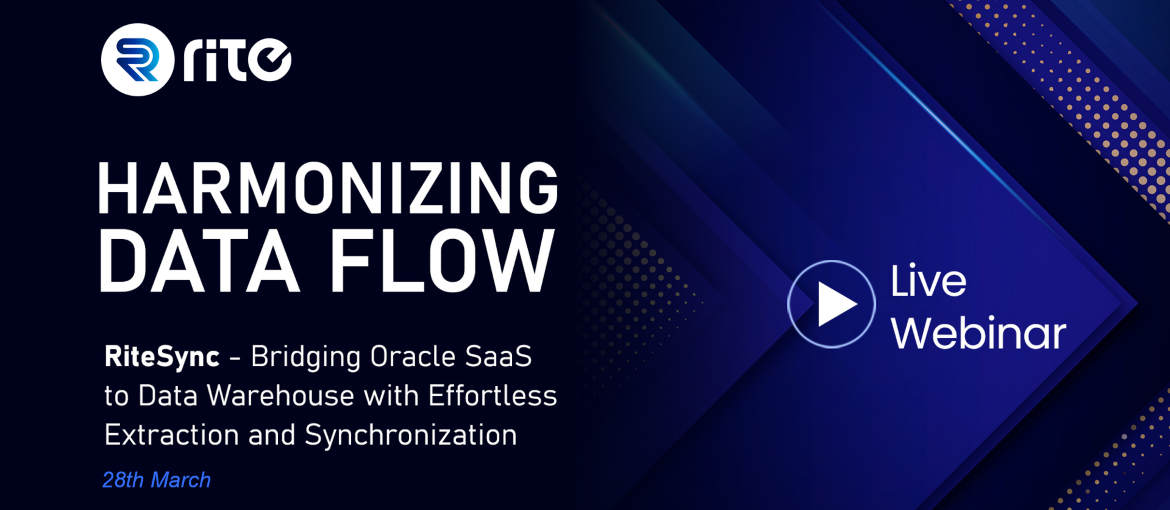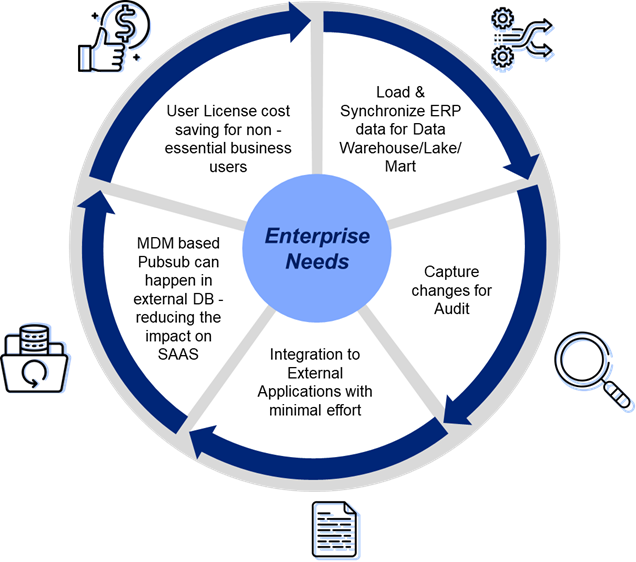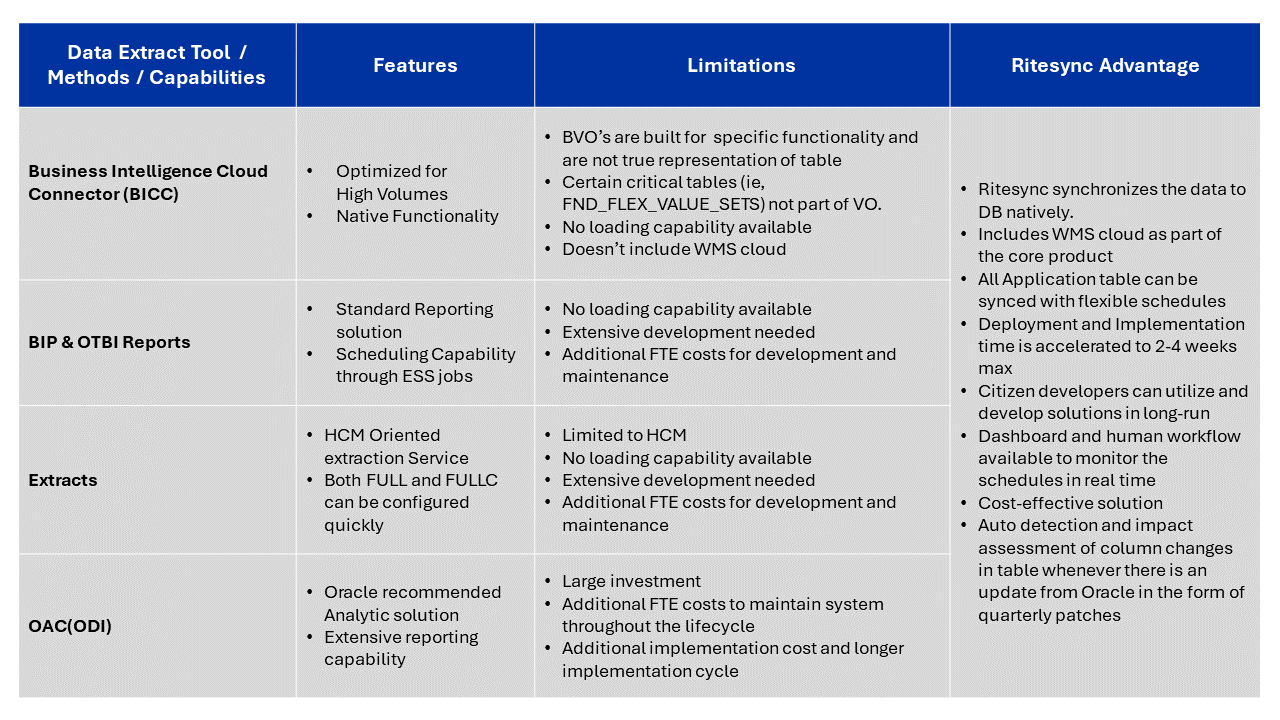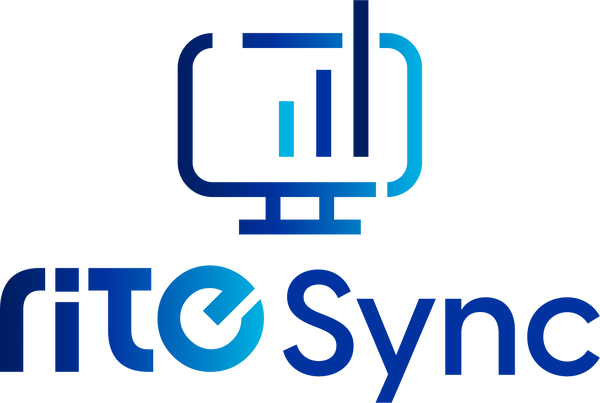RiteSync is an Extraction and Synchronization tool for Oracle SaaS Customers. But is that all? No.

- April 16, 2024
- Mohammed Nadeem Uddin
- 0
Let us double click on the multiple questions discussed in the webinar! One after another
What is RiteSync?
RiteSync is a tool designed for Oracle SaaS customers, simplifying the task of synchronizing data between Oracle’s cloud services (like Oracle ERP Cloud and Oracle WMS Cloud) and various databases or data warehouses. Its main purpose is to make it easier and more error-proof to transfer data from Oracle SaaS platforms to other systems.
It uses built-in connectors, such as REST JDBC, to facilitate seamless data transfer and reduce the chance of errors. With continuous innovation, RiteSync today can integrate with Oracle WMS cloud, comes with pre-built dashboards, reducing the latency.
Additionally, RiteSync assists customers in using tools like Power BI, Snowflake, and Incorta, enabling them to gain actionable insights from their data without being limited to the more expensive Oracle Analytical Cloud. It allows synchronization of application tables or reports from Oracle SaaS to databases like Oracle, Postgres, MySQL, or MS SQL Server, essentially replicating the data in these databases.
A key feature of RiteSync is its patent around metadata management, ensuring that all Oracle attributes are accurately captured and replicated in the chosen database or data warehouse. It also offers data in a Parquet file format, known for its efficient compression, making it ideal for use with modern BI systems.
In summary, RiteSync provides Oracle SaaS customers with a versatile and efficient tool for data synchronization, supporting a wide range of databases and facilitating the use of advanced analytics platforms.
Who would need RiteSync? What industries and what stage of ERP implementation does one need to be in, to make the most of RiteSync?
RiteSync is primarily used by those looking to synchronize their ERP data with their data warehouse. This includes data warehouses chosen based on strategic decisions, like opting for Snowflake, Incorta, Power BI, or traditional data warehousing solutions, to integrate data from Oracle SaaS. However, beyond this primary use, customers have discovered additional valuable applications of RiteSync.
One such application is for change audits, where RiteSync is employed to monitor and audit changes in specific tables, providing a consolidated view across different applications where Oracle’s reports don’t meet the user’s needs.

Another innovative use of RiteSync is as an integration tool. Users leverage it to pass on data transformed through BIP reports into other systems, including legacy systems. This eliminates the need for using Oracle’s OAC, which is more costly. RiteSync presents a cost-effective alternative, significantly reducing expenses compared to OAC and simplifying the integration process to a mere button click without needing specialized knowledge in OAC.
Additionally, RiteSync has been used to support the development of APEX-based applications, particularly useful for reducing licensing costs. It enables the creation of applications outside of SaaS for users only requiring read-only access, thereby avoiding the need for these users to log into SaaS and incur additional licensing fees. These applications can range from reporting tools to operational platforms.
Furthermore, RiteSync has found a niche in scenarios requiring publish and subscribe functionalities in a master data management context. It serves as a more efficient conduit for data distribution among external systems, reducing the reliance on Oracle SaaS’s web services and thereby optimizing system performance and cost.
To conclude, RiteSync extends well beyond its initial purpose of data synchronization, proving to be a versatile tool in change audits, system integration, application development, and data management strategies, offering cost-efficient and simplified solutions for Oracle SaaS customers.
Can we quickly compare RiteSync with Oracle Extraction Toolset?
RiteSync offers a compelling alternative to Oracle’s Business Intelligence Cloud Connector (BICC) for architects familiar with both tools. BICC, while optimized for high volumes and natively provided by Oracle, faces limitations such as not loading data directly into databases and missing critical tables for import, which could be crucial for application table migration. Although BICC includes customization options, these can be cumbersome and resource-intensive to implement.
Many customers who initially used BICC, attracted by its capability for handling large data volumes, have shifted to RiteSync. They found BICC’s maintenance costly and its functionalities, like delivering data only in CSV format and lacking an efficient way to handle anomalies in data (e.g., double quotes in clogged data), not fully meeting their needs. Moreover, BICC does not support WMS Cloud, presenting a significant gap for customers using this service.

On the other hand, RiteSync is designed to efficiently synchronize data with databases, including support for WMS Cloud, which is particularly relevant given its distinct architecture from other Oracle offerings. RiteSync also enables flexible scheduling, surpassing BICC’s daily scheduling limitation by allowing hourly updates, crucial for real-time data needs like monthly GL balances.
For citizen developers and those requiring streamlined data integration without extensive development, RiteSync proves to be a cost-effective and efficient solution. It simplifies the implementation of data pipelines and integration projects, allowing functional experts to leverage BIP reports and synchronize data across systems with ease.
All in all, RiteSync positions itself as a versatile and user-friendly alternative to BICC, especially for those facing BICC’s limitations or requiring integration with WMS Cloud. With features like flexible scheduling, support for a wide range of databases, and easier maintenance, RiteSync offers significant advantages for organizations looking to optimize their Oracle SaaS data synchronization and integration processes.
Time for some customer stories:
Banking Customer Smoothly Migrates Over 1 billion Records from Oracle HCM to Workday with RiteSync
Enhancing Financial Dashboards with RiteSync for an AMS Customer
Streamlining Data Migration for a Pharmaceutical Giant in Egypt
Here are some questions that the audience had.
We believe you too, will benefit from these.
All of this shows how RiteSync is an extraction and synchronization tool but can do so much more for you!
Wanna try it out yourself? Sign-up for our 7-day trial



Services
Products
Company
Copyright © 2024 Rite Software Solutions & Services LLP. All rights reserved.



